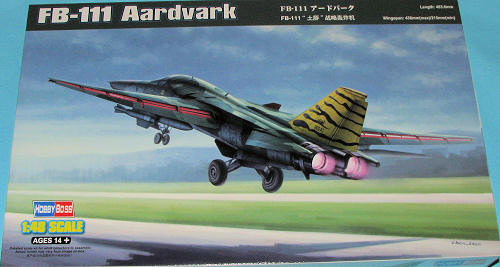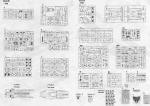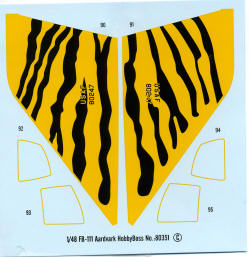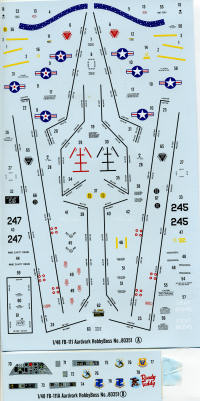
Hobby Boss 1/48 FB-111A Aardvark
| KIT #: | 80351 |
| PRICE: | 109.99 MSRP |
| DECALS: | Two options; one from each bomb wing that operated the type. |
| REVIEWER: | Scott Van Aken |
| NOTES: | Fourth variant of the kit. |

| HISTORY |
The General Dynamics F-111 "Aardvark" is a medium-range interdictor and tactical strike aircraft that also fills the roles of strategic bomber, reconnaissance, and electronic warfare in its various versions. Developed in the 1960s and first entering service in 1967, the United States Air Force (USAF) variants were officially retired by 1998. The Royal Australian Air Force (RAAF) is the sole remaining operator of the F-111.
The F-111 pioneered several technologies for production military aircraft including variable-sweep wings, afterburning turbofan engines, and automated terrain following radar for low-level, high-speed flight. Its design was influential, being reflected in later Soviet aircraft such as the Sukhoi Su-24, and some of its advanced features have since become commonplace. During its inception, however, the F-111 suffered a variety of development problems, and several of its intended roles, such as naval interception, failed to materialize.
In USAF service the F-111 has been effectively replaced by the F-15E Strike Eagle for medium-range precision strike missions, while the supersonic bomber role has been assumed by the B-1B Lancer. In 2007, the RAAF decided to replace its 21 F-111s in 2010 with 24 F/A-18F Super Hornets.
The FB-111A was a strategic bomber version of the F-111 for the USAF Strategic Air Command. With Air Force's Advanced Manned Strategic Aircraft program proceeding slowly, and concerns of fatigue failures in the B-52 fleet, the service needed an interim bomber quickly. The FB-111A was to selected in 1965 to replace the elegant but troublesome supersonic B-58 and early models of the B-52. The Air Force signed a contract for the FB-111A in 1966. Initially in 1968 263 aircraft were planned, but the total was cut to 76 in 1969. The first production aircraft flew in 1968. Deliveries ended in June 1971.
When the United Kingdom canceled its order for the F-111K in 1968, components for the 48 F-111Ks in manufacturing were diverted to FB-111A production. The FB-111A featured longer F-111B wings for greater range and load-carrying ability. Its fuel capacity was increased by 585 gallons (2,214 L) and had stronger landing gear to compensate for the higher maximum takeoff weight of 119,250 lb (54,105 kg). All but the first aircraft had the Triple Plow II intakes and the TF30-P-7 with 12,500 lbf (56 kN) dry and 20,350 lbf (90 kN) afterburning thrust.
The FB-111A had new electronics, known as the SAC Mark IIB avionics suite. For the FB-111A the system used an attack radar improved from the F-111A's system, along with components that would be used on the F-111D, including the inertial navigation system, digital computers, and multi-function displays. Armament for the strategic bombing role was the Boeing AGM-69 SRAM (short-range attack missile). Two could be carried in the internal weapons bay and four more on the inner underwing pylons. Nuclear gravity bombs were also typical FB armament. Fuel tanks were often carried on the third non-swivelling pylon of each wing. The FB-111A had a total weapon load of 35,500 lb (16,100 kg).
Multiple advanced FB-111 strategic bomber designs were proposed by General Dynamics in the 1970s. The first design, referred to as "FB-111G" within the company, was a larger aircraft with more powerful engines with more payload and range. The next was a lengthened "FB-111H". It featured more powerful General Electric F101 turbofan engines, a 12 ft 8.5 in longer fuselage and redesigned, fixed intakes. The rear landing gear were moved outward so armament could be carried on the fuselage there. The FB-111H was offered as an alternative to the B-1A in 1975. The similar FB-111B/C was offered in 1979 without success.
The FB-111A became surplus to SAC's needs after the introduction of the B-1B Lancer. The remaining FB-111s were subsequently reconfigured for tactical use and redesignated F-111G. The conversions began in 1989 and ended after 34 F-111G conversions were completed. With the disestablishment of SAC, the FB-111As and F-111Gs were transferred to the newly established Air Combat Command (ACC). They were used primarily for training.
The F-111G did undergo an avionics upgrade program that added a digital computer, dual AN/ASN-41 ring-laser gyro INS, AN/APN-218 Doppler navigation, and an updated terrain-following radar. The remaining FB-111As were retired in 1991 and the F-111Gs were retired in 1993. Australia later bought 15 F-111Gs to supplement its F-111Cs.
| THE KIT |
 Starting with the A model Hobby Boss has released a C variant as well as the D/E version and now the FB-111A model. This should given them all the bits they need to do an F and G, though really, this kit could well be used for the latter. I's be surprised if an EF-111A isn't also in the works. I doubt if HB will do the F-111B but one never knows. The look of the kit reminds me quite a bit of the Hasegawa 1/72 F-111 series, but there are probably only so many ways to mold a kit like this. Like the Hasegawa kit, it is designed to be built with the wings fully forward, so you need to keep that in mind when it comes to shelf space. I didn't see any swept back option.
Starting with the A model Hobby Boss has released a C variant as well as the D/E version and now the FB-111A model. This should given them all the bits they need to do an F and G, though really, this kit could well be used for the latter. I's be surprised if an EF-111A isn't also in the works. I doubt if HB will do the F-111B but one never knows. The look of the kit reminds me quite a bit of the Hasegawa 1/72 F-111 series, but there are probably only so many ways to mold a kit like this. Like the Hasegawa kit, it is designed to be built with the wings fully forward, so you need to keep that in mind when it comes to shelf space. I didn't see any swept back option.
Once one is able to get the box open, a virtual plethora of sprues awaits one's eyes. This is not a bare bones kit by any means and among its features are complete engines, a separate escape pod, a full radar set, deployed flaps and slats for the wings, and the ability to show the canopy sections open or closed. The bomb bay can also be posed open or closed. The kit also includes rubber tires and removable panels on the nose section to show off the equipment bay. A most complete set of weapons and stores are also provided that include MERs and TERs, Mk 20 Rockeye cluster bombs, Mk 82 slick 500 lb bombs, AMC-142 missiles. GBI-10 and GBU 15 Laser Guided Bombs, ALQ-119, 131 and 87 jamming/ECM pods, AIM-9B Sidewinders and a pair of large fuel tanks. Most photos I've seen of FB-111As shows them with more than two large fuel tanks so perhaps it would be worth seeking another pair or two. Some of these weapons may not be appropriate to this version, but it is nice to have them. The bomb racks include separate hold downs. The kit also comes with the guidance pod that can be put into the bomb bay. I'm not sure if this was an FB-111A item or not, but it may have been part of the F-111G fit. A nice touch is that the upper and lower fuselage halves, clear bits and rubber bits are all contained within a separate box to keep them from damage.

 Instructions are typical of Hobby Boss in that all twelve construction steps are well drawn. They also cover both sides of two large folded sheets. A load out diagram is also included that oddly, shows nothing carried on station one. Markings are provided for two aircraft.
Instructions are typical of Hobby Boss in that all twelve construction steps are well drawn. They also cover both sides of two large folded sheets. A load out diagram is also included that oddly, shows nothing carried on station one. Markings are provided for two aircraft.
The decals are very nicely done and include all the various data markings needed. A separate sheet contains markings for the pods and weapons. Markings are included for two planes. One is the box art plane in the striking Tiger Meet markings from 1978 from the 509th Bomb Wing. The other is from the second FB-111A wing, the 380th and is in a standard SIOP scheme with the markings for 'Ready Teddy'. This unit put names and nose art on all its planes from the WW2 schemes carried by the 380th. Paint information is for several paint makers but not for FS595, which would be quite useful. Even though the instrument panel and consoles are nicely detailed, you are given a decal to add to things. A full color painting and markings instruction sheet is provided and the decals are very nicely printed. I've had good luck with Hobby Boss decals so they should prove no issue. Though multiple paint sources are provided, it would have been nice to have the FS 595 references as well. For the record, the standard 70's SAC SIOP scheme consisted of FS 34079 Green, FS 34159 Green, FS 34201 Tan, with the standard white anti-flash bottom. The kit instructions would have you paint the underside a light grey, but in reality, it should be white (though it probably got rather dirty over time). There is also a sheet for weapons markings that is not shown.
| CONCLUSIONS |
In all, this is a very complete and quite detailed kit. It is a far cry from the troublesome Academy versions and should make a lot of 1/48 F-111 fans quite happy. For sure it is not a weekend edition and the finished model should be very impressive indeed.
| REFERENCES |
http://en.wikipedia.org/wiki/General_Dynamics_F-111_Aardvark
October 2010
My thanks to Squadron Products for providing the preview kit. Get yours today at your local retailer of have them order one for you.
If you would like your product reviewed fairly and fairly quickly, please contact the editor or see other details in the